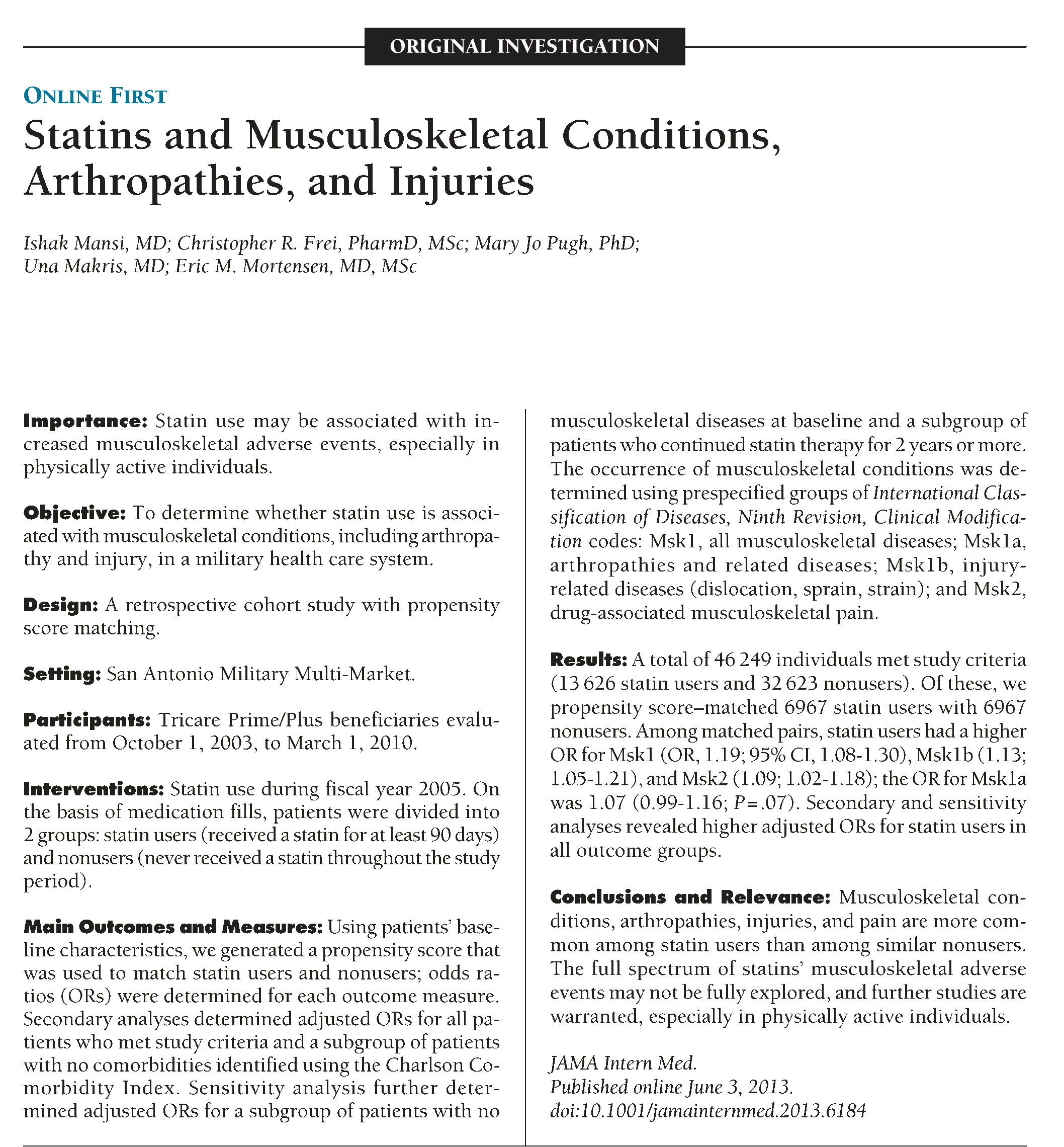This is junk science because:
The reported results are statistically weak and not at all impressive (weak associations with borderline significance from a retrospective cohort study). It’s impossible with these data to attribute the slight excess in musculoskeletal injuries exclusively to statin use.
Although we have long opposed the overuse of statins (they seem only to provide benefit in men with a history of heart disease), at least that track record is based on solid statistics. We won’t use weak claims to throw stones.
The media release and abstract are below.
###
Musculoskeletal conditions, injuries may be associated with statin use
Using cholesterol-lowering statins may be associated with musculoskeletal conditions, arthropathies (joint diseases) and injuries, according to a report published Online First by JAMA Internal Medicine, a JAMA Network publication.
While statins effectively lower cardiovascular illnesses and death, the full spectrum of statin musculoskeletal adverse events (AEs) is unknown. Statin-associated musculoskeletal AEs include a wide variety of clinical presentations, including muscle weakness, muscle cramps and tendinous (tendon) diseases, the authors write in the study background.
Ishak Mansi, M.D., of the VA North Texas Health Care System, Dallas, and colleagues utilized data from a military health care system to determine whether statins were associated with musculoskeletal conditions based on statin use during the 2005 fiscal year. Patients were divided into two groups: statin users for at least 90 days and nonusers. A total of 46,249 patients met the study criteria and of those, researchers propensity score-matched (a statistical approach that mathematically matches the characteristics of patients in two or more groups) 6,967 statin users with 6,967 nonusers.
“Musculoskeletal conditions, arthropathies, injuries and pain are more common among statin users than among similar nonusers. The full spectrum of statins’ musculoskeletal adverse events may not be fully explored, and further studies are warranted, especially in physically active individuals,” the authors notes.
Statin users had a higher odds ratio (OR) for musculoskeletal disease diagnosis group 1 (all musculoskeletal diseases: OR, 1.19), for musculoskeletal disease diagnosis group 1b (dislocation/strain/sprain: OR, 1.13) and for musculoskeletal diagnosis group 2 (musculoskeletal pain: OR, 1.09), but not for musculoskeletal disease diagnosis group 1a (osteoarthritis/arthropathy: OR,1.07), according to study results for the propensity score-matched pairs.
‘To our knowledge, this is the first study, using propensity score matching, to show that statin use is associated with an increased likelihood of diagnoses of musculoskeletal conditions, arthropathies and injuries. In our primary analysis, we did not find a statistically significant association between statin use and arthropathy; however, this association was statistically significant in all other analyses,” the authors conclude. “These findings are concerning because starting statin therapy at a young age for primary prevention of cardiovascular diseases has been widely advocated.”.
###

My wife has arthritis. She experiences joint and muscle pain as a side effect of *opening* the childproof bottles the pills come in.
Incidentally, stains are directly associated with muscle and joint injury.
Grass stains for field work injuries
Mud stains for wet work injuries
Wine stains for drinking problems
Blood stains for every injury.
I’ve got it. I’ve got it. People who exercise wind up staining their t-shirts and people on statins who take up exercising wind up with stains and strain-type injuries, so stains are associated with statins and musculo-skeletal injury.
I do have some covered-up stains but fewer than the current President.
“(I’m not on statins, incidentally.”
But are you on stains? That could be a real problem, another cover up.
I thought Stains were caused by blueberries. They are difficult even for Tide to wash out.
“Stains”? But I figured you meant statins.
A possible correlation here is multiple-birthday syndrome, of which I am something of a victim. It’s possible, at least, that some people who have had coronary artery events and who have started statin therapy are also increasing their physical activities as part of a cardiac health plan. Such people are likely to be in the 50x-70x multiple-birthday cohort, possibly higher, and this cohort (my own) tends to be a bit creaky due to reduced elasticity of various connective tissues. Increasing physical activity would very likely expose some to use-strain injury and others to traumatic injury in events that wouldn’t have been a problem when they were MBS40x-50x.
I happen to have stepped badly off of a curb only a couple of weeks ago. Something I used to shake off, or so I recall, laid me by the heel for a few days and has limited my walking quite a bit. Was it a more severe sprain than those I used to walk off, or was it more severe due to MBS? I dunno. But that’s a possible variable in the statin consideration. (I’m not on statins, incidentally.)